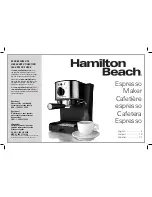
48
7
INFORMA
TION CONCERNING
HANDLING AND
INST
ALLA
TION
Decommissioning, scrapping, and disposing of the machine
During decommissioning, to prevent the machine becom-
ing a hazard, all the parts used to connect it to the power
supply must be rendered unusable.
Drain away any liquids in the machine that could be an
environmental hazard.
When the appliance is demolished, all the parts must be
separated according to their chemical characteristics and
disposed of in compliance with the relative laws in force.
Do not dump non-biodegradable products, lubricants, and
non-ferrous materials (rubber, PVC, resins, etc..).
Comply with Article 14 of DIRECTIVE 2012/19/EU OF
THE EUROPEAN PARLIAMENT AND OF THE COUNCIL
of 4 July 2012 on waste electrical and electronic equip-
ment (WEEE).
The crossed-out rubbish bin symbol found on the machine
or on the packing means that the product must be dis-
Final inspection testing
Once the installation and electrical connections are com-
plete, the following activities must be carried out by qual-
ified workers.
1)
Check that the safety devices required are installed
and in good working order.
2)
Check that the requirements concerning operating con-
ditions are met.
3)
Clean the machine (see “Cleaning and initial start-up
after prolonged disuse”).
posed of separately from other waste at the end of its use-
ful life.
Disposal of the machine at the end of its working life is
organised and managed by the manufacturer.
If you wish to scrap the machine, you must contact the
manufacturer and follow the system established thereby
for the disposal of the machine at the end of its life.
Suitably sorting the parts of the machine in preparation
for its scrapping (and subsequent recycling and environ-
mentally compatible disposal) helps to prevent potential
adverse effects on the environment as well as on health
and safety, and facilitates the reuse and/or recycling of its
constituent materials.
Unlawful disposal of the machine by the owner will result
in the application of the administrative penalties provided
for by applicable legislation.
Summary of Contents for STUDIO AQUA
Page 2: ......
Page 51: ...49 49 49 ENCLOSURES A Wiring diagram 100 120 V 50 60 Hz...
Page 52: ...50 50 50 50 ENCLOSURES A Wiring diagram 200 240 V 50 60 Hz...
Page 55: ...53 53 53 NOTES...
Page 56: ...54 54 54 NOTES...
Page 57: ......









































